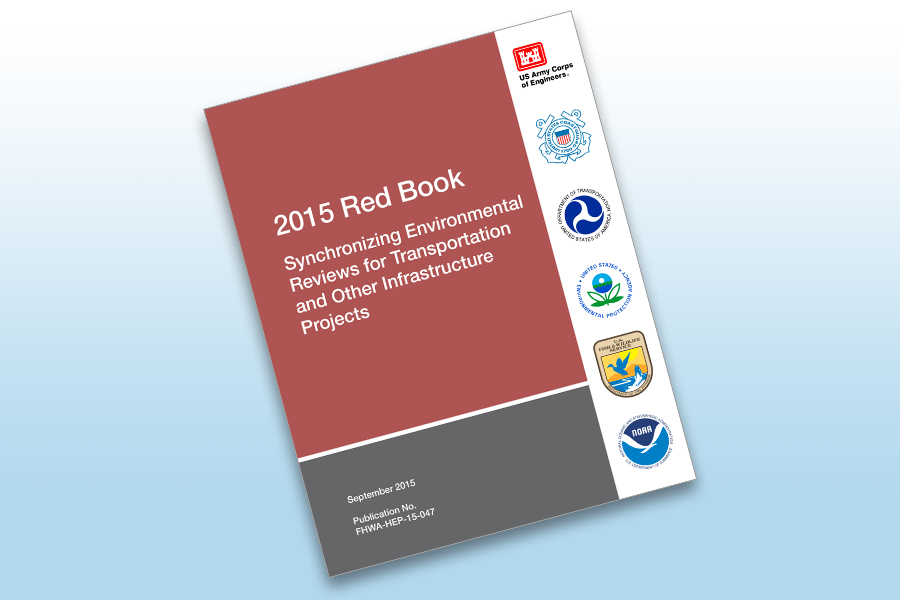May 31, 2018
Innovation of the Month:
Integrating National Environmental Policy Act and Permitting
Several resources are available to help agencies deploy the Every Day Counts round four (EDC-4) initiative on integrating National Environmental Policy Act (NEPA) and permitting processes:
- Watch a webinar on integrating NEPA and permitting for local, tribal, and Federal land management agencies.
- Read the “2015 Red Book: Synchronizing Environmental Reviews for Transportation and Other Infrastructure Projects” for a how-to guide on integrating project reviews.
- Use the eNEPA project collaboration tool for an electronic system that facilitates coordination among agencies to complete necessary permitting processes.
- Visit the Integrating NEPA and Permitting Resources Library for case studies, templates, State agreements, publications, and presentations.
- See the Environmental Review Toolkit for information and resources on NEPA and project development.
Contact Mike Ruth of the Federal Highway Administration Office of Planning, Environment, and Realty for information and technical assistance.

2D Hydraulic Modeling Enhances Design Process for National Park Road
A 2015 storm caused severe damage throughout Death Valley National Park in California, including washing out an 8-mile road segment that provides access to a prominent tourist attraction. To determine the best approach to reconstructing the damaged road, Federal Lands Highway (FLH) used two-dimensional (2D) hydraulic modeling, a strategy promoted in the EDC-4 initiative on collaborative hydraulics: advancing to the next generation of engineering (CHANGE). Applying 2D modeling enabled the FLH team to develop a cost-effective design to increase the sustainability of the road by realigning it away from the flood channel and redirecting the channel where necessary to provide water to a wetlands area. For information on the project, contact Brent Nagen of FLH. For information on CHANGE, contact Scott Hogan of the FHWA Resource Center.
Diverging Diamond Interchanges Improve Safety in Missouri
The Missouri Department of Transportation (MoDOT) is a leading champion of the diverging diamond interchange (DDI), an EDC innovation that enhances safety by reducing the number of intersections or other traffic conflict points where collisions can occur. MoDOT built the Nation’s first DDI in 2009 on I-44 in Springfield. Within a year, the DDI reduced injury-only crashes by 80 percent and all crashes by 53 percent. In the decade since, MoDOT has built 19 more DDIs. Their latest DDI, at I-49 and 155th Street in Grandview, incorporates a roundabout, another EDC safety innovation, instead of a traffic signal at one of the ramp terminals. Read about MoDOT’s DDI leadership in a U.S. Department of Transportation Connections blog post by Acting Federal Highway Administrator Brandye Hendrickson. View a MoDOT video that shows how DDIs help keep traffic flowing effectively. For information on DDIs and roundabouts, contact Mark Doctor of the FHWA Resource Center.
Nominate Your STIC for a 2018 Excellence Award
Nominations for the 2018 State Transportation Innovation Council (STIC) Excellence Award are open until July 1. FHWA's Center for Accelerating Innovation (CAI) partners with the American Association of State Highway and Transportation Officials Innovation Initiative on the award, which recognizes STICs that have achieved significant results in fostering a strong culture of innovation. This award provides an opportunity to share specific examples of how your STIC is making a difference and the results of these efforts. Learn more about the 2016 and 2017 STIC Excellence Award winners. For information, contact Sara Lowry of CAI.
About EDC
Every Day Counts, a State-based program of the Federal Highway Administration’s Center for Accelerating Innovation, works with State, local, and private sector partners to encourage the adoption of proven technologies and innovations to shorten and enhance project delivery.


